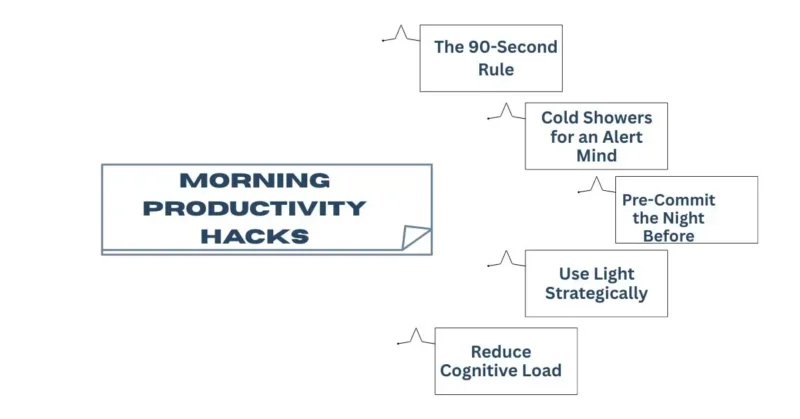Boost morning productivity by understanding the role of energy and routine. Learn how to create a morning routine that works for you and sets you up for success.
Thank you for reading this post, don't forget to subscribe!How to Boost Morning Productivity: Energy vs. Routine Strategies
Are you tired of feeling sluggish and unproductive in the mornings? Do you struggle to get motivated and focused? The key to unlocking morning productivity lies in understanding the delicate balance between energy and routine. While some people swear by strict morning routines, others find that their energy levels dictate their productivity. In this post, we’ll explore the relationship between energy and routine and provide you with actionable tips to boost your morning productivity and set yourself up for success.
The Role of Energy in Morning Productivity
How Energy Levels Define Morning Success
Energy is the currency of productivity. Without it, even the most well-planned routine fails. Your physical and mental energy levels when you wake up set the tone for your performance throughout the day. That’s why understanding how energy flows through your body and mind in the early hours is essential for mastering your mornings.
The body’s circadian rhythm plays a crucial role. This internal clock influences when you feel alert or sluggish. Aligning your morning productivity with your natural peak energy periods results in better concentration, faster task completion, and improved mood.
How Nutrition Fuels the Morning Engine
Start with hydration. Dehydration after sleep causes fatigue and brain fog. A glass of water upon waking boosts cellular function and mental clarity.
Follow with a nutrient-rich breakfast. Choose complex carbohydrates, proteins, and healthy fats to sustain energy levels. Oatmeal with nuts and fruits, Greek yogurt with chia seeds, or eggs with whole-grain toast offer long-lasting fuel.
Avoid sugar-laden or high-caffeine starts. While coffee temporarily spikes alertness, it often leads to mid-morning crashes. Instead, combine it with slow-release foods to stabilize blood sugar and energy output.
Exercise: The Natural Energy Booster
Morning workouts increase blood circulation and oxygen flow to the brain. Even a 10-minute brisk walk triggers endorphins that enhance alertness and positivity. Incorporating light stretching or yoga reduces stiffness, improves posture, and sets a proactive mental state.
High-intensity workouts in the morning may work for some, but low-impact movement is more sustainable and energizing for most. The key is consistency, not intensity.
Mindfulness: Mental Energy Matters
Mindful practices like meditation or breathwork help regulate cortisol and reduce mental clutter. A five-minute session can lower anxiety and increase focus, preparing the mind for high-efficiency work.
Journaling thoughts, affirmations, or setting daily intentions clears cognitive noise and channels energy toward meaningful goals.
The Power of Routine in Morning Productivity
Why a Consistent Morning Routine Works
Routine programs your brain to operate on autopilot, saving decision-making energy. When you eliminate micro-decisions (like what to eat or wear), you reserve mental power for tasks that require real effort.
A consistent start builds momentum. You signal your brain to move from rest to action through repeated cues. Over time, these cues develop into habits that automate performance and reduce procrastination.
Crafting a Personalized Morning Routine
A powerful routine doesn’t copy someone else’s checklist. It aligns with your life, your energy patterns, and your priorities. Start by identifying what activities uplift you and which ones drain you.
Structure your mornings around 3 pillars:
- Preparation—Lay out clothes, prep breakfast, and outline your agenda the night before.
- Activation—Stretch, move, hydrate, and fuel.
- Focus—Block out noise, open your planner, and start with your most important task.
If you work from home, include boundaries like a dedicated workspace and digital curfew. If you commute, buffer time to avoid stress.

Energy vs. Routine: Finding the Right Balance
When Energy and Routine Clash
Even the most structured routine crumbles under exhaustion. Relying solely on routine ignores the natural fluctuations of energy caused by poor sleep, illness, or stress.
Conversely, chasing energy without routine creates chaos. Despite feeling great, you may lack direction. That’s why both must coexist.
How to Sync Energy and Routine
Use your high-energy phases for cognitively demanding tasks. It usually occurs within 1 to 3 hours of waking. Schedule routine-based tasks like checking emails or cleaning during energy dips.
Let your energy levels shape the flow, but let your routine shape the structure. Together, they create a responsive and resilient productivity model.
Time Management Techniques for the Morning
Use time-blocking to assign chunks for specific types of work based on energy. Start with deep-focus tasks (writing, planning), followed by medium-level tasks (emails, calls), and end with administrative ones (filing, organizing).
Apply the Pomodoro technique—25 minutes of work, 5 minutes of rest—to maintain mental stamina.
Anchor your routines with fixed time markers like “start the task at 9:00 AM” rather than vague cues like “after breakfast.”
Morning Productivity Hacks

The 90-Second Rule
When facing a task you’re resisting, commit to it for just 90 seconds. Often, starting is the hardest part. Once in motion, momentum carries you forward.
Cold Showers for an Alert Mind
Cold water exposure triggers adrenaline, wakes up the nervous system, and enhances alertness. Even a 30-second cold blast can make a difference.
Pre-Commit the Night Before
Set up your environment for success. Lay out clothes, prep your desk, and write your first three to-dos. Morning fog is real—your night self should be your morning coach.
Use Light Strategically
Open the blinds or step outside. Natural light regulates your circadian rhythm and reduces melatonin, making you feel more awake and focused.
Reduce Cognitive Load
Eliminate early decisions. On the weekdays, have the same breakfast. Maintain simple clothing. To free up time for more in-depth work, automate the start.
Creating a Sustainable Morning Routine
Why Sustainability Beats Intensity
An unsustainable routine is worse than no routine at all. Going from zero to a two-hour complex ritual sets you up for failure. A sustainable routine fits your lifestyle, scales slowly, and adjusts when needed.
Consistency is built on small, manageable changes that compound. Wake up just 10 minutes earlier. Meditate for only 2 minutes. Win the day by starting small and showing up daily.
Adaptive Routines for Real Life
Life is unpredictable—travel, illness, and family emergencies. Your routine should flex, not break. Create a core routine of non-negotiables (e.g., hydrate, stretch, review goals) and optional extensions (e.g., journal, long workout) you add when time allows.
Keep your essentials portable. Can’t hit the gym? Do bodyweight exercises. No time to journal? Do a 30-second audio log on your phone.
FAQs
Q. What is the best morning routine for productivity?
The best morning routine for productivity begins with waking up at a consistent time, followed by hydration and light movement like stretching or a short walk to awaken the body. A nutritious breakfast with protein, fiber, and healthy fats supports mental clarity. Next, a brief mindfulness practice, such as journaling or meditation, helps clear your mind. Prioritize your top task using a planner or to-do list. Avoid checking emails or social media first thing, as they can derail your focus. Stick to this structured flow daily to create momentum and peak productivity.
Q. What is the healthiest thing to do first thing in the morning?
The healthiest thing you can do first thing in the morning is drink a full glass of water. After hours of sleep, your body is dehydrated, and hydration jumpstarts digestion, metabolism, and brain function. Follow this with some gentle stretching or movement to improve circulation. Avoid screens initially; instead, let natural light reset your internal clock. Deep breathing or short meditation reduces cortisol and promotes calmness. These small actions promote both physical and mental well-being. Over time, they lay the foundation for a healthier, more energized start to your day.
Q. What is the 20/20/20 rule for the morning routine?
The 20/20/20 rule is a morning routine popularized by Robin Sharma that divides your first hour of the day into three powerful blocks. The first 20 minutes are for exercise to get your heart rate up and energize your body. The second 20 minutes are for reflection—this could include journaling, meditation, or planning your goals. The final 20 minutes are for growth—reading, listening to a podcast, or learning something new. This method helps you take control of your morning with balance and focus. It sets a powerful tone for the rest of the day.
Q. How can we get more energy and productivity?
To gain more energy and productivity, start by improving your sleep quality—aim for 7 to 9 hours nightly. Fuel your body with balanced meals rich in whole foods, and hydrate early and often. Move your body daily, even if it’s just a brisk walk or light stretching. Practice mindfulness to reduce stress, which drains mental energy. Structure your day with time blocks to avoid decision fatigue and distractions. Most importantly, create routines that align with your natural energy rhythms. Over time, these habits build stamina and help you get more done with less effort.
Conclusion: Your Morning is Your Launchpad
Neither energy nor routine fuels your productivity—it’s the synergy between the two. Energy brings life to your routine, and routine provides structure to your energy.
A productive morning isn’t built overnight. It’s the result of intentional energy management, personalized habits, and continuous adaptation. Start by observing your current patterns. Refine what works. Ditch what doesn’t. And remember, progress is better than perfection.
Elevate your mornings by listening to your body, respecting your rhythm, and building routines that uplift you. When you do, productivity becomes effortless.
Read more articles on Health Tips.
You might like:

